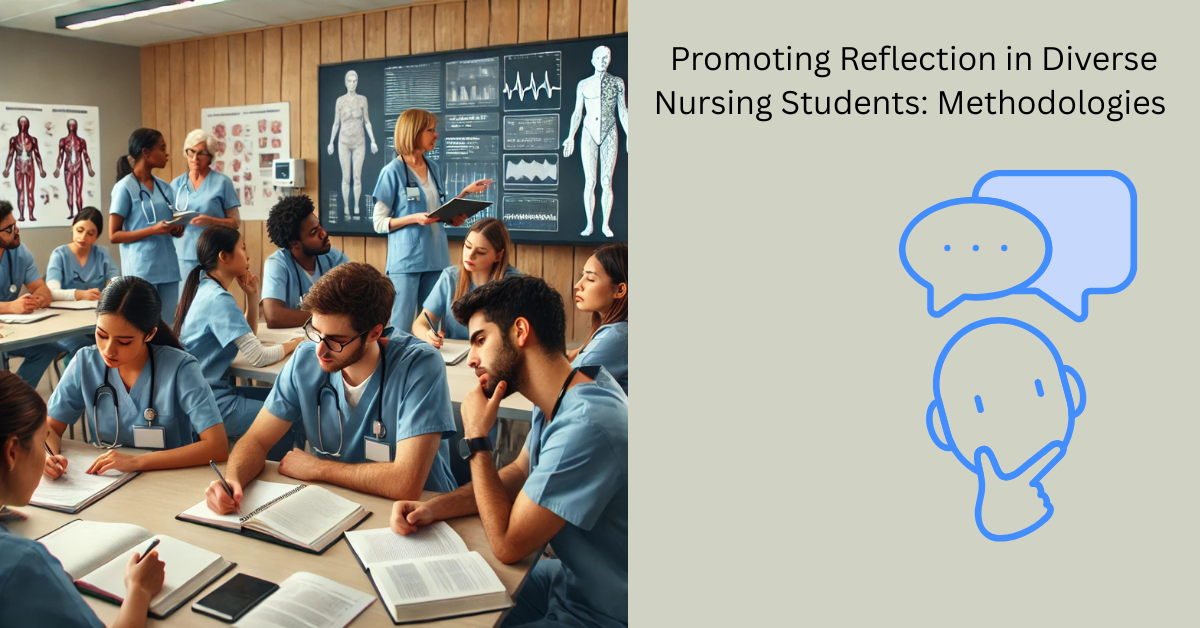While dealing a diverse group of students Promoting Reflection in Diverse Nursing Students Methodologies is and educational responsibility of educators and education institutes. Here is philosophical view and curriculum need to design for this purpose.
Methodologies for Promoting Reflection in Diverse Nursing Students
Service Learning
Another methodology that encourages interaction, caring, and dialogue is service learning. A service-learning project can be integrated into the curriculum as an assignment. Service learning is getting the students out into the community in the form of a partnership. The students learn from the experience and they “give back” to humanity a needed service. Service learning is a philosophy of cultural awareness and does not count as clinical hours.
Vanderhoff (2005) defines service learning as “giving students the opportunity to provide service to others while tying in learning objectives and a class project for professional development” (p. 36). It is more than volunteerism because students receive a percentage of their grade for it. It is more than just community service; it is course-based educational experience for credit (Bentley & Ellison, 2005).
Service learning can take place in local community-based settings or even internationally (Perry & Mander, 2005). Service learning entails recognizing the needs of the community or a given patient population (Vanderhoff, 2005). Service learning can be enacted in many ways and forms. One class, for example, developed a service-learning project in which students were randomly divided into groups for “Teddy Bear Clinics” on Sundays at different parishes in a local area.
The Teddy Bear Clinics were advertised through the parish nursing and focused on teaching young children health promotion. Children came to the clinic with a stuffed animal and pretended to be a parent with a child. The children were escorted through stations by a nursing student. The stations each had a different theme, such as handwashing, teeth brushing, injury prevention, first aid, and safety.
After the clinic, the students wrote a reflective paper on what they learned from the experience in relation to their experience and ability to communicate information to children and a diverse group of parents. Another class took blood pressures at the mall and parishes and counseled people on healthy heart diets. This service project became more than just a blood pressure screening.
Student journals indicated that it became a forum in which students learned to interact with the public in a professional role. This journal entry illustrates the effectiveness of service learning: I enjoyed this experience. I only took blood pressures on a few people; However, I thought there was more that we were doing. One elderly gentleman sat and talked with me for quite some time. I felt like he really wanted to sit with someone and have them listen to him.
It made me feel as though I had helped out much more than I had initially thought I would or could that day. It was very nice to be able to help those people out (Blackboard electronic journal from 1-22-06). This project helped make students more culturally competent by breaking down barriers through reflection and discussion of real life experiences. It is very difficult for students working on a service-learning project together not to interact constructively.
A cooperative purpose is always a powerful tool in education. Service learning has increased in popularity in recent years and may be directly linked to the service-learning boom at the high school level (13 million high school students participate in service learning each year). Almost 30% of the 6.7 million students in public and private 4-year college settings participate in a course in which service-learning is integrated into the curriculum (National Service Learning Clearinghouse, 2004).
Also, about 50% of the community colleges offer service learning courses throughout disciplines (National Service Learning Clearinghouse, 2004). Bentley and Ellison (2005) called service learning a “powerful learning experience” (p. 287). It should have a two-fold purpose. It should meet both the students’ needs and the community needs. Bentley and Ellison (2005) used service learning in a course in which 16 nursing students partnered with Head Start to assist teenagers to transition into parenthood. Qualitative data showed positive enrichment from the students.
Quantitatively, it was evaluated against a control group on the Health Education Systems Incorporated (HESI) scores. The experimental or service-learning students scored higher on the comprehensive HESI, designed to test nursing knowledge, but not significantly (service-learning group, M 92.01; control, M 90.22). These results show a trend towards service learning as an educational enhancement in the understanding of nursing curriculum content.
The ingredients that have been identified for academic-community partnerships by Plowfield, Wheeler, and Raymond (2005) are applicable to service learning. The ingredients include time, tact, talent, and trust. Time must be invested by the teacher to establish the relationship with the agency or community service being utilized. Connections have to be established person to person and electronically to understand the needs of both groups and the resources available.
Time is also a detriment to the process because establishing a service-learning curriculum is time-intensive on faculty who are already overextended. Tact is necessary to ensure a trusting relationship. Communication is a key element as is maintaining the vision of the project throughout the process of detailed analysis. Tact calls for respect, which means prompt answers, attending to matters, answering questions, and anticipating problems. Talent is recognizing and celebrating different areas of expertise in situations.
Plowfield, Wheeler, and Raymond (2005) state, “no one wants to invest time and resources when objectives are not clear or the path to achieving them is fraught with obstacles” (p. 219). Talent guards against this pitfall in service learning. Building trust is an ongoing process, forged through the other three values in a service learning project. Trust is built through open dialogue and tact while working together on mutual goals (Plowfield, Wheeler, & Raymond, 2005).
Perry and Mander (2005) used an international service-learning model in which nursing students traveled abroad for a focused learning experience in maternal-child health. The experience started in well-developed countries where the students were acculturated into the health-care system, then it expanded to third world countries where the students provided service.
Service was rendered through nursing care and bringing supplies and resources. The journaling comments from the students and faculty regarding the experience supported that these projects enhanced knowledge and cultural sensitivity in a way that could not be accomplished in a classroom. Consider one student’s comment:
It was an unforgettable experience that I will treasure for the rest of my life. The trip has definitely empowered me as a future nurse and as a woman through the learning process of this great adventure (p. 151).
A long-standing, 8-year, service-learning project at Capstone College of Nursing of the University of Alabama, has students enrolled in a fundamental nursing class participate in a project that provides health screening and physical assessments on K through 12 school students. The outcomes of this project include enhancements in skill, clinical decision-making, and communication (Adams, 2004; Denner, Coyle, Robin, & Banspach, 2005).
Dialogue
Perry and Mander (2005) state, “Don’t criticize or comment on differences, appreciate them” (p. 148). How does that appreciation develop? The first way would be to experience it—experience it through true dialogue. Someone cannot actually experience the history of another but can understand that history better through communication.
Communication is the essential ingredient to promoting positive group dynamics, if the communication is open, honest, and done in a flexible environment (August-Brady, 2000). Classroom discussion is a wonderful tool to create an environment of empathy and understanding. But due to curriculum demands, classroom time is limited.
Other techniques, such as 10-minute diffusion time, and electronic discussion platforms, may be necessary to assist in facilitating communication to assist intercultural, intercollegial appreciation. These quick dialogue techniques may help a group of diverse students “gel” and acquire a positive learning experience without undo time commitment.
10-Minute Diffusion Time
Setting 10 minutes aside at the end of class for storytelling enhances dialogue and understanding. Trying to pick a specific topic, such as “Who witnessed a birth this week?” or “Who felt more comfortable in clinical this week with a specific skill?” can start a story. This is different from post-conference because the entire group is together, not just the clinical group. Even though time allocated to this methodology is minimal, often the conversations spill over into the hall after class and students take time out to listen to each other and tell their own stories (Irvin, 1996).
Discuss Electronically
Opening the discussion board for threads about specific topics and nonspecific topics assists students to share and become aware of each other. One technique is to open an uncensored thread that is just for the students and promise not to enter the thread. Other discussion threads can be opened for specific student groups.
Groups can be composed of students from the same clinical group or they can be random. Interest groups for a specific topic or dilemma have also been used. Discussion threads of random groups usually need a topic to start the conversation. If the discussion is a class expectation, or takes the place of post-conference, it is easy to use a rubric that clarifies what the expectations of the discussion.
Socialization
Accelerated and weekend/evening programs place a very restrictive schedule on the adult student. Although students are aware of the academic schedule when they enter the program, it is different once it is being “lived.” Scheduled socialization breaks promote integration of the group, role modeling of the culture of nursing, and stress relief (Murray & Main, 2005).
Understanding that the students in a classroom today have differences in culture, age, learning styles, and expectations can set up nurse educators for difficult teaching circumstances. Having “down” time in which students can mingle and dialogue on a different level than the classroom is a great way to establish a trusting relationship that may not be fostered in the formal setting.
Pizza parties, meet and greet sessions with light snacks, brown bag lunches, family nights, and movie nights are just a few examples of ways to enhance socialization. Nursing education is a rigorous curriculum that is stressful and affects the entire family. Downtime and socializing with faculty and other students in a different setting assists in relationship building and communication (Miklancie & Davis, 2005).
Summary
The nurse educator today is likely to face a classroom of students with much different demo graphics and numbers than in days past. Classes are larger and comprise more adults and returning students than ever before. Learning styles differ by individuality, culture, and age. Pedagogies that enhance inter-student understanding and caring can only promote understanding and caring in nursing practice.
Using old standby pedagogies exclusively may not meet the expectations of today’s learners. Methodologies that promote dialogue, value clarification, and caring are needed to help students socialize into a caring profession. Reflection and awareness of values, attitudes, bias, and appreciation for life experience must be integrated with content in a flexible educational environment. Our classrooms and clinical groups are microcosms of the patient-care area; caring for each other must be integrated to be realized in the professional role.
Read More:
https://nurseseducator.com/promoting-reflection-in-groups-of-diverse-nursing-students
Social Links:
https://www.facebook.com/nurseseducator/
https://www.instagram.com/nurseseducator/



